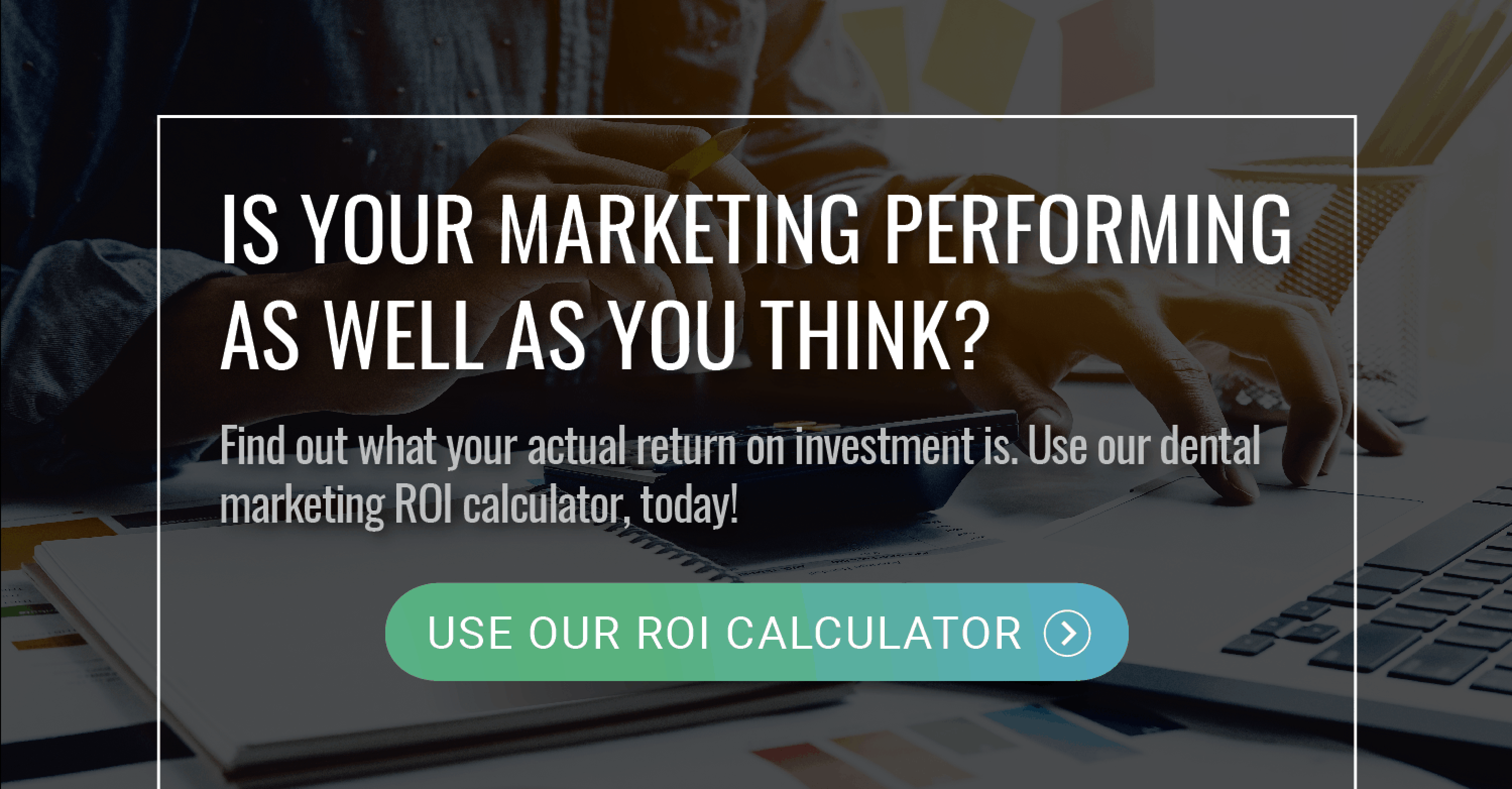Dental ROI: How To Get the Most From Your Dental Marketing Budget

“Half the money I spend on advertising is wasted;
the trouble is I don’t know which half.”— John Wanamaker
If you’re not measuring your dental ROI don’t be (too) ashamed. You’re not alone.
One survey conducted by Dental Economics found that more than 50% of dental practices don’t track the results of their marketing efforts effectively. Based on what we’ve seen, it’s closer to 90% and the remaining 10% are fibbing.
Without tracking, you could be wasting even more than half of your money. But it doesn’t have to be that way. Here’s a quick primer on how you can determine your practice’s dental marketing return on investment (ROI) and know if you’re spending your marketing budget wisely.
Understanding Marketing ROI
The simple definition of marketing ROI is how much profit you gain from your efforts divided by your expenses. There are two types of dental ROI plan options when calculating return on investment.
Short Term vs. Long Term ROI
Short term dental ROI looks strictly at immediate profitability, usually a particular campaign or channel like pay-per-click or radio. The simple representation of this formula is…
ROI% = ((Revenue – Cost) / Cost) x 100
Simply take the amount of new patient fees you generated from your marketing (revenue) minus the amount of money you spent (cost) and divide that difference by the cost. Multiply the result by 100 to convert to a percentage.
Long term dental ROI takes a more meaningful look at the budget for your dental marketing strategies, since it considers both the immediate and ongoing revenue you will generate from each new patient you acquire over the entire time they remain active at your office. That method of calculating ROI for dental practices is a bit more complicated, but we do have an easy alternative.
Getting Accurate Data
First things first, there are some key pieces of data you will need to accurately calculate your long term dental ROI.
About Your Marketing
- A specific time frame (e.g., the past six months)f
- How much you spent on marketing during that time frame
- The number of new patients you acquired from that marketing
About Your Dental Practice in General
- The average revenue you generate per patient per year
- The average number of years your patients remain active at your practice
(According to the ADA, 7-10 is typical) - The number of referrals you receive from patients per year
Calculating Long Term Dental ROI: The Hard Way
With all your data in hand, it’s time to pull out the calculator. Remember the simple formula we used above?
ROI% = (Revenue – Cost) / Cost x 100
That still works, but we need to dig into the Revenue component a bit deeper.
First, you need to calculate your Lifetime Patient Revenue (LPR).
LPR (Lifetime Patient Revenue) = Average Number of Years Patients Remain Active at Your Office x Annual Revenue per Patient
Successful practices also get a number of referrals from happy patients, so we need to factor that in with a Patient Referral Multiplier (PRM).
PRM (Patient Referral Multiplier) = Annual Number of Patient Referrals / Number of Active Patients
So, your total Lifetime Patient Value (LPV) equals:
LPV (Lifetime Patient Value) = LPR + (PRM x LPR)
Okay, next we can calculate the long term Revenue.
Revenue = Number of New Patients x LPV
Now you can go back to the original formula and plug in your Revenue and Cost values to calculate your ROI.
ROI% = ((Revenue – Cost) / Cost) x 100
Simple, right? No worries, we have a better way.
Calculating Long Term ROI: The Easy Way
If you don’t happen to be a math geek or a dental marketing expert, you can also take the information you gathered and just plug it into our handy Dental Marketing ROI Calculator. Easy peasy.
Once you have your ROI value, it’s time to figure out what it means.
Interpreting Your Results
So, the moment of truth. A good return on investment for dental practices is generally considered to be 300-500% or better, depending on how mature that office’s strategy is. If your ROI is higher than that, terrific! Go ahead and pump money into that profit-generating marketing machine.
If you fall below 300%, it would be worthwhile to take a closer look at your marketing efforts. Sometimes, disappointing numbers are just the result of poor tracking, and you may actually be getting better results than you think. (Yes, that’s the optimistic outlook.)
If you think your numbers are reasonably accurate, it may take some digging to figure out exactly where you’re leaking profits, but generally, there are two ways to improve your ROI.
Example: Calculating ROI on Dental Practice SEO Campaigns
Let’s look at an example. Let’s say your team is determining endodontic ROI from your latest marketing campaign around treating root canals, which focused heavily on boosting your local SEO. When determining how to measure SEO ROI for dental practices, you’ll first use various tools to pull important data. This information will provide you with an overview of important metrics like keyword rankings, organic traffic, and conversions. This targeted dental ROI process allows you to easily compare your online visibility before your SEO efforts vs after, as well as how online engagement improved in your local community. With this information, you can start to calculate how much revenue came from SEO-driven conversions. All of this data used together allows you to compare data, consider whether you’re getting enough return on investment, and make an informed decision.
Improving Your Dental Marketing ROI
Reduce Your Cost of Acquiring New Patients
If your overall ROI is low, you may be dumping money into one or more strategies that aren’t producing results. You can apply the same calculations to individual efforts to find the culprit, just make sure the number of new patients and cost are specific to that marketing campaign.
Cost is most often inflated by a poor lead conversion process. If you are generating a good number of prospective patients, but not a lot of actual appointments, investing the time and effort to train your front desk staff on patient conversion may be the solution.
Increase Your Lifetime Patient Value
It’s also possible that you aren’t getting as much value from your patients as you can, possibly because they aren’t staying with your practice very long, they aren’t referring new patients, or they simply aren’t getting treatment or preventive care as frequently as they should. Providing an outstanding patient experience tends to solve all of those problems, and doesn’t cost you a penny.
Find Out Your ROI Today
Find out if you’re half right or half wrong! Grab your data and try our Dental Marketing ROI Calculator today to get an immediate assessment of the effectiveness of your marketing. If you want to learn more about the top strategies for improving your dental ROI, request a 30-minute breakthrough call today. We’ll walk you through the latest digital marketing solutions to help you grow your practice.
